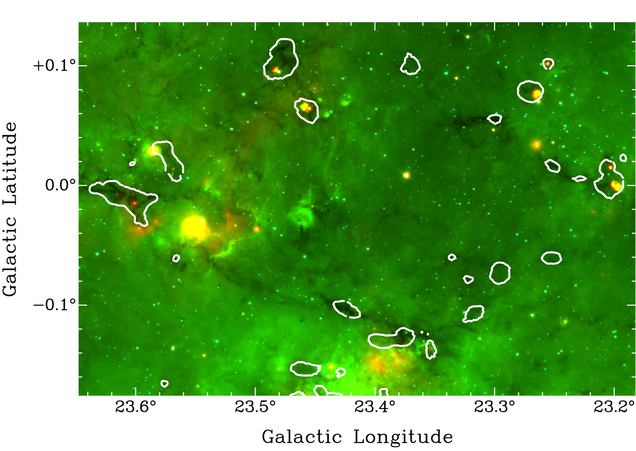Project Summary
High-mass stars (M > 8 MSun), though rarer than low-mass stars, are nevertheless a dominant source of energy and chemical enrichment in the interstellar medium (ISM). Because massive stars are rarer and form in denser, more opaque gas, their formation is more difficult to observe and is less well understood than for low-mass stars. Considering that high-mass stars form in dense (n~104 cm-3) molecular clumps (M=200-5000 MSun, R~1 pc), the study of these clumps is important. Thus, we have undertaken RAMPS to help answer some of the open questions concerning high-mass star formation.
RAMPS is particularly well suited to help answer three open questions.
- How do high-mass star-forming clumps evolve? We can estimate the evolutionary state of a clump from its mid-infrared emission. The figure below shows the 3.6 µm (blue) and 8 µm (green) emission from GLIMPSE (Churchwell et al. 2009), the 24 µm (red) emission from MIPSGAL (Carey et al. 2009), and RAMPS NH3(1,1) integrated intensity contours in white. We will separate the clumps RAMPS detects into three categories: “quiescent” (mid-infrared dark), “protostellar” (compact 24 µm emission), and “H II region” (extended 8µm emission). In addition to tracing the dense gas where high-mass stars form, the NH3 inversion lines can estimate several important quantities. In local thermodynamic equilibrium, these NH3 lines provide us with the gas temperature, the NH3 column density, and the turbulent velocity dispersion. We will then investigate how these quantities, as well as the presence of H2O and CH3OH masers, change as a function of evolutionary state.

- What is the role of filaments in high-mass star formation? Infrared and radio continuum surveys of the Galactic plane have shown that filamentary structures are common in the ISM, but the role these filaments play is still uncertain. With RAMPS we can deduce the velocity dispersion, the linear mass density, and the spacing of clumps along filaments, information that can help us better understand the structure and fragmentation of filaments.
- What is the Galactic distribution of star formation and evolved stars? Through measured clump velocities, NH3 lines also provide kinematic distances. While a single velocity may correspond to two possible distances, the kinematic distance ambiguity can be resolved by the presence or absence of H I aborption/self-absorption (Whitaker et al. 2017). With the Galactic coordinates and distance to each detected clump, we can determine the 3D Galactic distribution of high-mass star-forming clumps. In addition to tracing active star formation, H2O masers also trace the asymptotic giant branch (AGB) star population. Thus, RAMPS can also provide some information on the spatial distribution of AGB stars in the Galaxy.
Reference
Please use the following reference for RAMPS data in your publication:
\bibitem[Hogge et al.(2018)]{2018ApJS..237…27H} Hogge, T., Jackson, J., Stephens, I., et al.\ 2018, \apjs, 237, 27
Acknowledgement
Please use the following acknowledgement in any publication that makes use of RAMPS data:
This publication makes use of molecular line data from the Radio Ammonia Mid-Plane Survey (RAMPS). RAMPS is supported by the National Science Foundation under grant AST-1616635.



